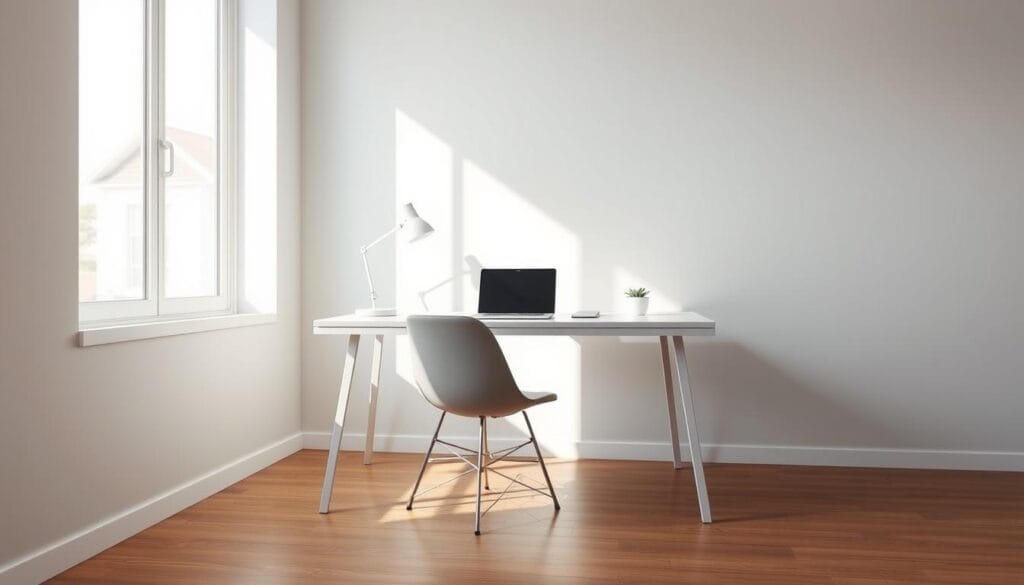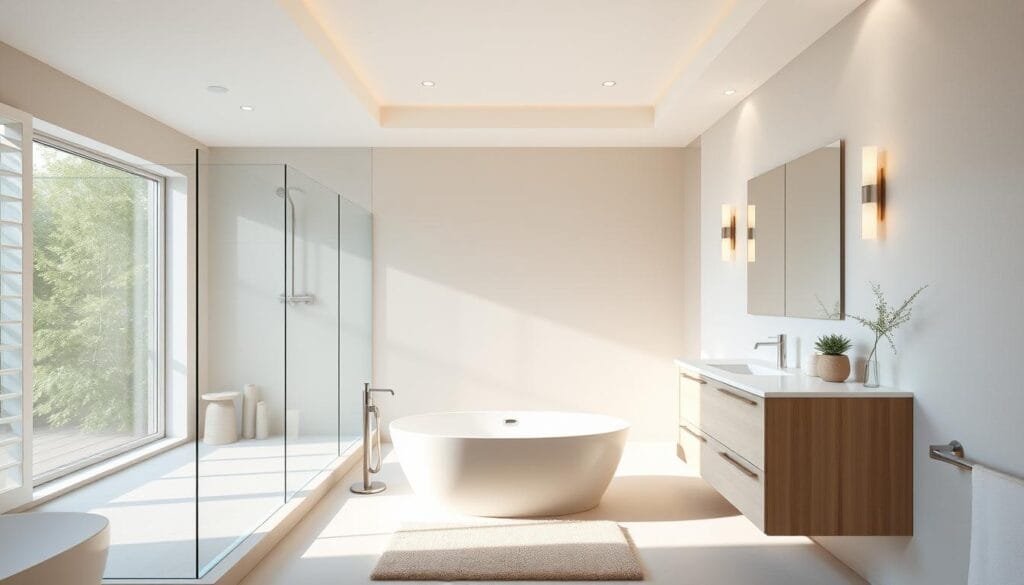Imagine it’s Monday morning and you’re walking into your home office to start the week. Your desk is cluttered, with paperwork everywhere, and distractions all around. How would it be, though, to walk into a peaceful, minimalist space where everything has a purpose? Let’s explore how minimalist design can make your workspace a productivity haven.
Adopting a minimalist office interior goes beyond following a trend. It’s about creating an environment that boosts focus and efficiency. Instead of going for flashy decor, minimalist design focuses on simplicity, functionality, and quality. Envision a workspace that embraces the “less is more” philosophy—a place that fuels your creativity and productivity. This approach works for both cozy home offices and corporate spaces, making your work area clear, organized, and inspiring.
Every choice, from the right color scheme to furniture layout, aims to lessen stress and promote clear thinking. Looking for ideas? Discover some excellent home office ideas for maximum productivity for inspiration!
Minimalist office interiors benefit from elements like morning sunlight and smart furniture placement to maximize space. Such environments boost mental clarity, spark creativity, and provide comfort during long work hours. A well-thought-out minimalist decor enhances productivity by creating a calm and stress-free workspace.
Ready to transform your office into a serene, efficient, and beautiful space? Continue reading for a wealth of sleek minimalist design ideas and tips. These will help make your office a tranquility and productivity oasis.
What is Minimalist Office Design?
Minimalist office design keeps things simple and functional. It gets rid of stuff you don’t need to make a space that’s neat and tidy. This style makes sure you have what you need to work well and feel inspired.
Definition and Key Features
This design is all about making your workspace neat and free from distractions. It uses calm colors like white, gray, and earth tones to make a peaceful place. Also, minimalist office furniture is sleek and mixes well with the room’s style.
Benefits of Minimalist Design
Making your office clean and tidy helps you focus better. A study from Harvard found that a neat office could make you 32% more productive. A simple space also makes you feel less stressed, which is good for you and your work. Using furniture that has more than one purpose helps keep things minimal, too.
Common Misconceptions
Some people think minimalist design is too plain or unwelcoming. That’s not true. Adding warm woods and comfy fabrics can make any space feel inviting. Minimalist furniture is also designed to be comfy and useful. And good lighting, like sunshine or stylish lamps, makes the area cozy and bright.
How to Start Your Minimalist Office Makeover
Starting a minimalist office makeover might seem hard, but it pays off. To begin, look at what you already have, decide on a budget, and plan your design. These steps can change any workspace into a productive and beautiful spot.
Assessing Your Current Space
First, we check out our office space carefully. This helps us see what we really need and what just takes up space. Studies say a clutter-free space can boost our work by 20-30%. It’s all about finding what’s necessary and ditching the rest.
Ask yourself, are there things you don’t need? Maybe some furniture isn’t used well? We aim to simplify, keeping only what makes us happy. This idea comes from Marie Kondo, who tells us to keep items that bring us joy.
Setting a Realistic Budget
Then, it’s time to think about our budget for redesigning the office. Planning our spending is key to not going overboard. Investing in things like modular partitions can save money. They’re not too pricey and add a lot of flexibility.
Minimalist design can also cut down care costs by up to 25%. This means we can buy high-quality, versatile furniture. Think of standing desks or floating shelves. Below are some costs to consider for our makeover:
| Item | Description | Price |
|---|---|---|
| Bay Isle Home Dyani Coffee Table | Laptop shelf, storage options | $169.99 |
| East Urban Home Desk | Minimalist design, hardwareless cabinets | $219.99 |
| Homeforia Rustic Farmhouse Floating Shelves (Set of 2) | Customizable storage solutions | $109.99 |
Creating a Design Plan
Last, we make a detailed design plan. We choose furniture that looks good and is useful. Standing desks, for example, are popular for their space-saving feature. Putting in furniture that saves space helps avoid clutter, which is great for smaller offices.
Combining a simple color scheme with minimalist furniture makes a peaceful space. This can make you 15% more happy at work, research says. Our design should focus on being simple, useful, and cozy. We use soft colors, smooth desks with lots of room, and natural light to inspire.
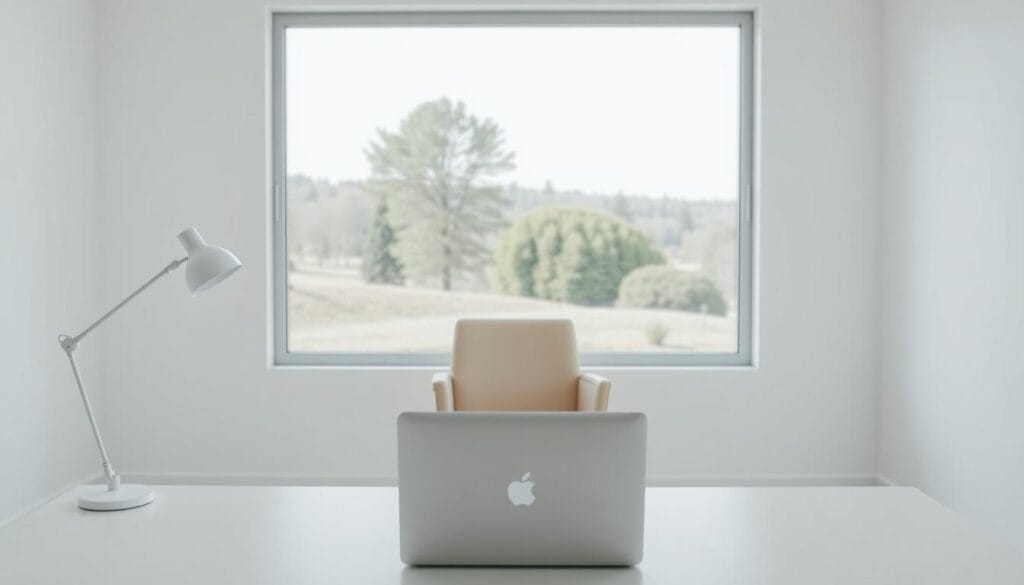
Essential Elements of Minimalist Office Design
Creating a minimalist office is about mixing beauty with practicality. It means focusing on clean lines, smart color use, and choosing furniture wisely. This approach boosts productivity and well-being. Here, we explore the key traits of a minimalist work area.
Color Schemes and Finishes
Neutral shades like whites, grays, and beiges dominate minimalist designs. These calm colors can make employees feel 30% less stressed. Adding these hues fosters a tranquil, focused workspace. Using glossy and matte textures adds depth without crowding the visual space.
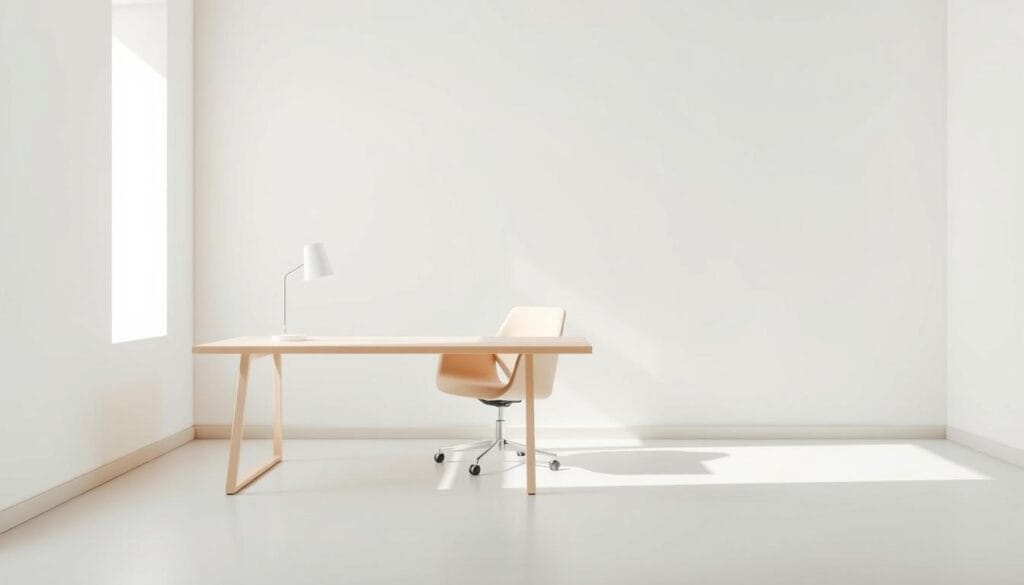
Furniture Selection and Layout
It’s important to pick the right furniture that looks sleek and serves a purpose. Choosing multipurpose pieces can free up to 40% of room space. Arranging furniture wisely promotes teamwork by 25% and boosts happiness at work by 60%.
Natural Light and Greenery
Bringing in sunlight and plants is key to minimalist design. Natural light brightens the area, cuts stress, and uplifts work output by up to 20%. Plants enhance air quality by 25%, making the office healthier and more welcoming. These choices help create airy, clutter-free spaces that spark creativity by 35%.
Decluttering Strategies for a Minimalist Office
Clearing out your office space is key to a minimalist, productive work area. Getting rid of stuff you don’t need makes your space look better and helps you work better. Research says a messy office can make you 30% less productive and 25% more stressed. Let’s dive into how you can declutter and organize your office.
The Importance of Decluttering
Knowing why it’s crucial to declutter is the first step to a minimalist office. People feel 70% more productive in a tidy space. Having regular clean-ups boosts team spirit by 40%. A neat desk means you spend 50% less time looking for things, so you can concentrate more on work.
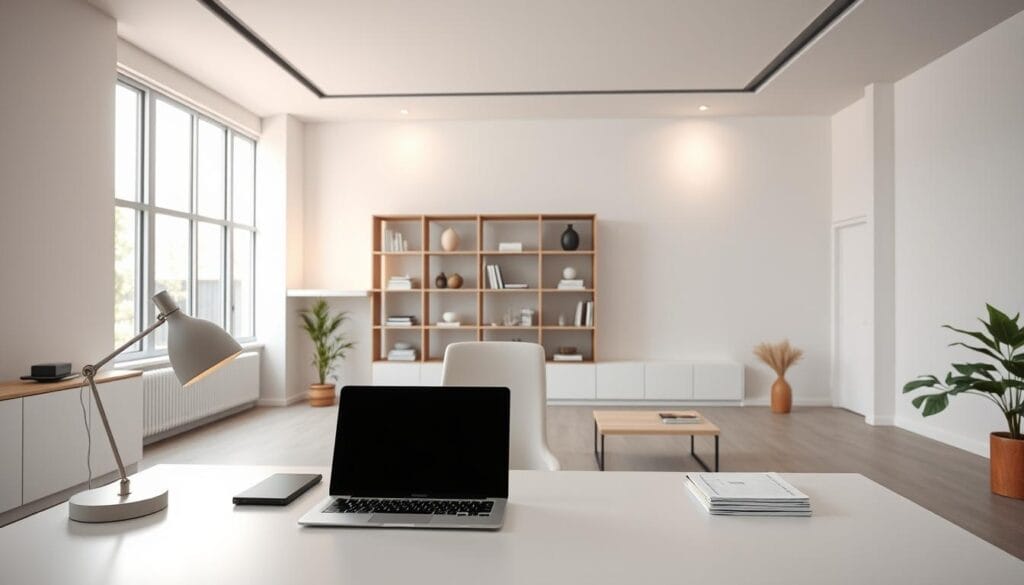
Tips for Effective Organization
Here’s how to keep your office minimal and functional:
- Minimalist Storage Solutions: Pick sturdy shelves and simple desk tools to keep just the important stuff in sight.
- Essential Items Only: Have only what you really need on your desk to minimize distractions. Use a “one in, one out” strategy to avoid clutter building up.
- Regular Maintenance: Plan frequent decluttering to stay efficient and keep clutter away over time.
Firms using these tips have seen a 15% boost in staff focus and creativity. It shows the clear perks of a well-kept office.
Digital Decluttering
Digital tidying is just as important. Keep your digital files sorted and cut down on online clutter to mirror your tidy physical space:
- Organize Files: A digital filing system can lessen the need for physical storage by 80%. Sort your documents well in a digital space and always back up.
- Minimize Distractions: Keep desktop icons to a minimum and close apps you’re not using for a calm digital area. Digital task managers can also help keep your work flow smooth.
Following these steps will unite your physical and digital spaces into a clean minimalist office design. Always remember, staying consistent and mindful is crucial for keeping up this productive setup.
Choosing the Right Furniture for Minimalism
When you pick minimalist office furniture, it’s vital to blend function and style. Every piece should have a purpose and keep the design simple. By choosing functional office furniture over just decorative items, you avoid clutter and create a peaceful work area.
Functional vs. Aesthetic
Minimalist design means practicality comes first. You should look for furniture that’s useful yet has a simple, elegant look. By focusing on functional office furniture, you select items that fit your needs but don’t overcrowd your space. Using neutral shades like white and black helps make a relaxing atmosphere, which is key in minimalism. Also, people working in minimalist spaces are 40% less stressed, showing why the right furniture matters.
Multi-Functional Furniture Solutions
In modern offices, multi-functional furniture is key. Pieces like sofa beds and desks with built-in storage save a lot of space. This means you can have a bigger area to work in, which helps make you 20-30% more productive. Such furniture keeps your office looking neat, which is essential in minimalism.
Recommended Brands and Styles
Some brands are great at making minimalist office furniture. IKEA and West Elm stand out for their modern, useful designs. Their furniture has simple lines, neutral colors, and is made of materials like wood and metal. This makes your office look classy and work better. Plus, 60% of workers say a well-organized space helps them enjoy their job more.
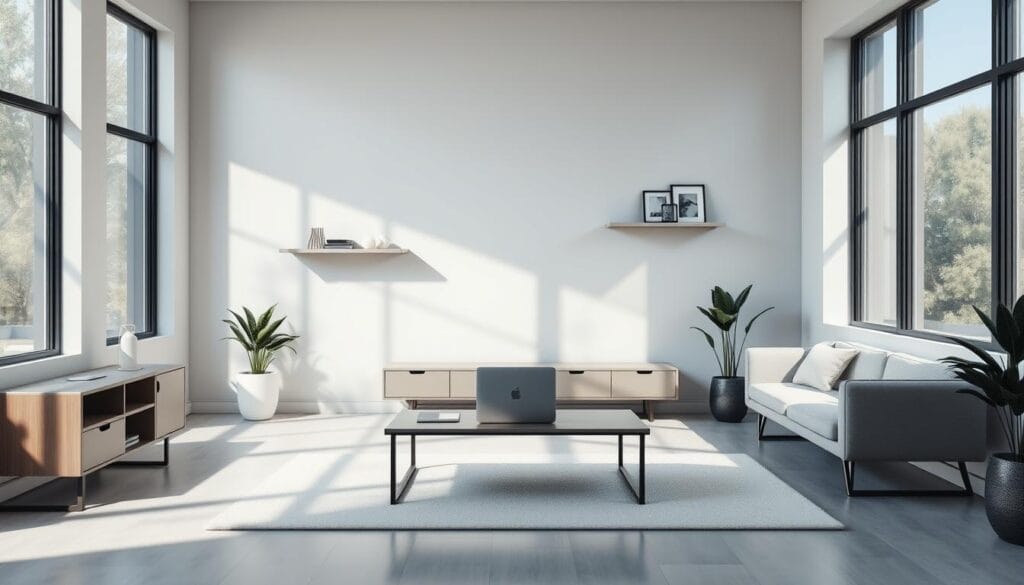
Here’s a quick comparison of essential features and suggested brands:
| Feature | Brand | Advantages |
|---|---|---|
| Neutral Color Schemes | IKEA | Calming, enhances mood by 20% |
| Multi-Functional Solutions | West Elm | Saves 30% floor space |
| Natural Materials | Herman Miller | Improves air quality by 25% |
| Durability | Steelcase | Investment in quality |
Lighting Ideas for a Minimalist Office
Lighting is key in a minimalist office. It boosts work and makes the space look good and feel cozy. Whether for a home office or a company setting, knowing your lighting choices helps a lot.
Types of Lighting to Consider
In a minimalist office, mixing ambient, task, and accent lighting is crucial. Ambient lighting lights up the whole area and is the main light source. You can use overhead lights like pendants and recessed lights for this. Task lighting, with things like adjustable desk lamps, is important for detailed work. Accent lighting adds flair by spotlighting specific spots or items. Together, they make the office both functional and stylish.
Natural vs. Artificial Light
Natural light is very helpful, as 70% of remote workers say it helps them focus and be more productive. Big windows, skylights, and mirrors help use natural light well, creating a lively space. But, not every place gets a lot of natural light. Then, we need artificial lights that work well with natural light and don’t hurt our eyes. Sixty percent of people struggle with eye issues if their home office light isn’t right.
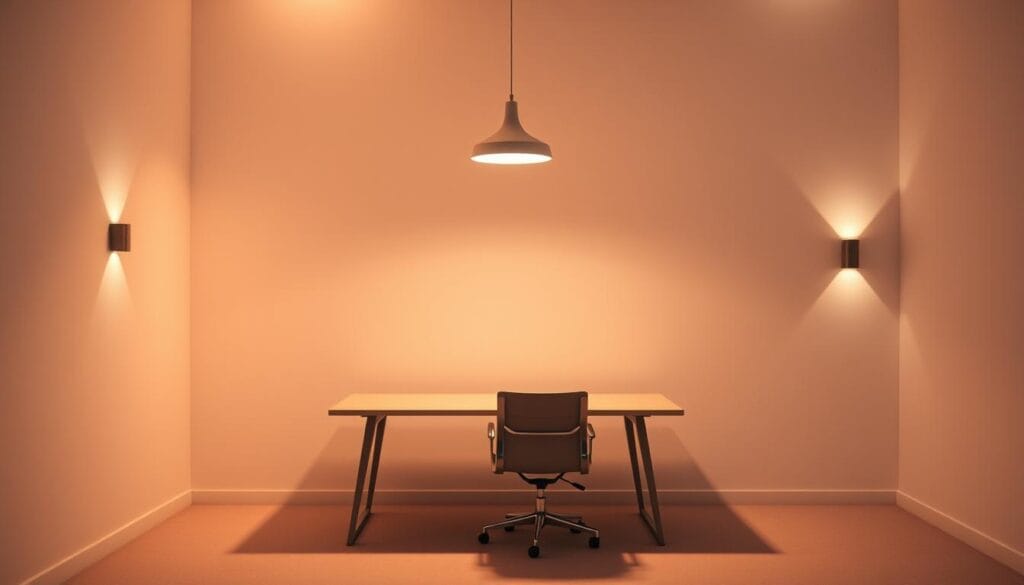
Smart Lighting Options
Smart office lighting is changing modern work areas. Sixty-five percent of people like smart bulbs that change lighting based on time and what you’re doing. These systems adjust light brightness and color temperature during the day. This keeps your work environment ideal. Also, 55% like the look and function of minimalist lamp designs.
Choosing minimalist office lighting wisely makes a big difference. It can improve work, mood, and happiness at work. Whether you love the simplicity of natural light or the tech of smart lighting, the right lighting makes your minimalist office a place full of creativity and productivity.
Incorporating Technology in Minimalist Design
Adding tech into a simple office setup boosts its look and use. This involves picking streamlined tools, managing cables well, and using smart devices. Let’s see how these can make your workspace better.
Streamlined Tech Tools
Picking the right minimalist tech tools keeps your space clean and open. Go for neat, multi-use devices that save space. Brands like Apple and Samsung fit perfectly into a minimalist office.
Cable Management Solutions
Office cable management is crucial for a minimalist look. Use cable boxes, clips, and sleeves to tidy up. Also, wireless and Bluetooth devices can cut down on cables showing.
Smart Home Integration
Minimalist smart home tech boosts your office’s effectiveness. It lets you control lights, heat, and security automatically. Smart glass can change from clear to private quickly, keeping the space feeling open. Adding smart film to glass bits is a sleek way to avoid bulky curtains, keeping things minimalist.
| Feature | Description |
|---|---|
| Smart Glass | Instant transition from transparent to opaque, offering privacy while maintaining elegance. |
| Retrofit Smart Film | Enhances functionality without the need for bulky window treatments, promoting simplicity. |
| Multi-functional Partitions | Acts as projection surfaces or whiteboards, reducing the need for extra furniture. |
Personal Touches in Minimalist Offices
Minimalist office design loves simplicity and function. But, personal touches can make it more comfortable and help you do better work. Let’s explore how to add meaningful touches without losing that minimalist feel.
Meaningful Artwork and Decor
Adding meaningful artwork and decor can really lift your spirits and spark creativity. Pick pieces that show off your personal style and values. They should fit the minimalist look with clean lines and neutral colors. Choosing art with meaning, like something that inspires you or holds dear memories, is key.
Remember, in minimalism, less is more. Often, one big, impactful piece is better than many small ones.
Customizing Your Workspace
Customizing your minimalist workspace is about mixing personal items with practical ones. Add a few key things that make work easier and more comfy. An ergonomic chair is great. It can boost productivity and cut down on back problems by about 15%.
Use simple storage solutions to keep things you need close but out of sight. Even a small touch, like a unique notebook or a stylish pen holder, can brighten your day.
Keeping It Functional and Simple
The key to a functional office is keeping it minimal. A tidy space helps us focus and work better. Clearing out clutter every three months can keep things in order. Neatly managing cords can cut down on mess by up to 40%.
Add some easy-care plants like succulents or snake plants. They look good and clean the air.
When we mix personal touches with smart, useful decor, we make places that are nice to look at and great for work. Happy designing!
Maintaining Your Minimalist Office Aesthetic
Keeping a minimalist office tidy isn’t hard. With a set cleaning schedule, your space can stay sleek. This helps boost productivity and keeps you motivated.
Regular Cleaning Routines
Start by setting up a weekly cleaning plan. A tidy workspace can make you 20% more productive by cutting down distractions. Clean surfaces, sort papers, and organize your desk every day. Use smart storage to hide things and keep your space open. In minimalist design, keeping it simple is the goal.
Tips for Sustainable Minimalism
Adding sustainable design to your office is good for the planet and improves your space. Pick durable, quality furniture to make your office look better and last longer. Go for calm colors like white, gray, and beige to lower stress by up to 30%. Let in as much natural light as you can. It can make everyone feel 15% happier and more satisfied.
Evolving Your Design Over Time
Your minimalist office can change as you do. Feel free to update it while keeping to minimalist ideas. Try a modular desk or furniture that can change for what you need. Adding things like comfy, ergonomic furniture can cut down physical stress, making you 15% more productive. Your office should change over time, meeting both your needs and style dreams.


